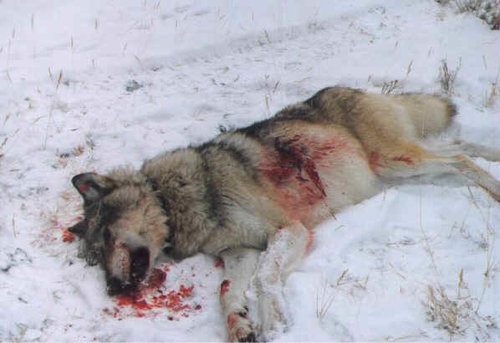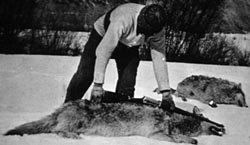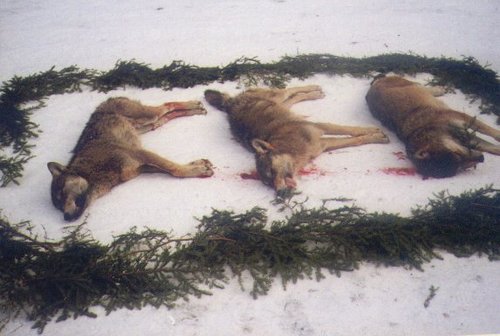SageGhost
New member
A rancher in remote Central Idaho shot a wolf he said was harassing his cattle, marking the first time one of the federally protected predators has been killed under new guidelines that took effect in February.
The rancher near Mackay shot the female gray wolf Sunday at 11 p.m. He watched it and another larger wolf chasing his cattle, the rancher told officials. The other wolf escaped.
Under the new rule that affects Idaho and Montana, people can now shoot wolves that pursue their livestock. Before, the rancher would have been forced to wait until a wolf had actually bitten one of his cows.
That change marked a first step in returning control of wolf populations to states and private landowners, who say they need it to limit depredation of livestock, domestic animals and wild game herds as wolf numbers steadily rise.
Federal officials have already determined the rancher acted appropriately. Wolf advocacy groups are reserving judgment pending an investigation.
"Under the new rule, the rancher was authorized to shoot the wolf," said Mark Collinge, director of the federal Wildlife Services Idaho office, which monitors predators preying on livestock in the state. He said it was the first under the new rule.
This is the third wolf killed legally in Idaho this year. Officers from Collinge's agency killed two in February after reports they'd preyed on cattle — killings that also would have been allowed under the old rules.
In 2004, Wildlife Services agents killed 17 wolves in Idaho, the most in any year since they were reintroduced to the region in 1995.
Meanwhile, wolf numbers in Idaho are expected to surpass 450 this year. The state's remote wilderness areas have made ideal breeding grounds.
In Sunday's incident, officials declined to give the rancher's name or exact location, fearing it could cause retribution on an issue that has polarized wolf advocates and critics.
Wildlife Services officials were on the scene Monday.
The dead wolf may have been a part of the nine-member Copper Basin pack or may have split off from that group. Authorities plan to examine the animal's stomach to learn about recent meals.
The wolf also will be examined for signs of breeding.
Federal officials described the events that preceded the shooting, saying the rancher called them Thursday to report that wolves caused his herd of cattle to stampede.
One calf was trampled to death, he told them.
The rancher wanted to know his rights under the new rule, which brings Idaho and Montana closer to the level of management they will enjoy when wolves are delisted under the Endangered Species Act. The federal government is waiting until a legal dispute is resolved in neighboring Wyoming before the wolf is delisted.
When the wolves returned to the property Sunday, officials say the rancher was ready.
"It appears the system has worked correctly and as we hoped it would," said Carter Niemeyer, the wolf recovery coordinator for the U.S. Fish and Wildlife Service in Boise.
Suzanne Stone, field representative of Defenders of Wildlife in Boise, said whether the rancher is eligible for compensation for the dead calf depends on whether he tried nonlethal methods of discouraging the wolf before shooting it. Defenders has paid out more than $430,000 since 1987.
i found this pic on the internet, nice visual aid !!!
The rancher near Mackay shot the female gray wolf Sunday at 11 p.m. He watched it and another larger wolf chasing his cattle, the rancher told officials. The other wolf escaped.
Under the new rule that affects Idaho and Montana, people can now shoot wolves that pursue their livestock. Before, the rancher would have been forced to wait until a wolf had actually bitten one of his cows.
That change marked a first step in returning control of wolf populations to states and private landowners, who say they need it to limit depredation of livestock, domestic animals and wild game herds as wolf numbers steadily rise.
Federal officials have already determined the rancher acted appropriately. Wolf advocacy groups are reserving judgment pending an investigation.
"Under the new rule, the rancher was authorized to shoot the wolf," said Mark Collinge, director of the federal Wildlife Services Idaho office, which monitors predators preying on livestock in the state. He said it was the first under the new rule.
This is the third wolf killed legally in Idaho this year. Officers from Collinge's agency killed two in February after reports they'd preyed on cattle — killings that also would have been allowed under the old rules.
In 2004, Wildlife Services agents killed 17 wolves in Idaho, the most in any year since they were reintroduced to the region in 1995.
Meanwhile, wolf numbers in Idaho are expected to surpass 450 this year. The state's remote wilderness areas have made ideal breeding grounds.
In Sunday's incident, officials declined to give the rancher's name or exact location, fearing it could cause retribution on an issue that has polarized wolf advocates and critics.
Wildlife Services officials were on the scene Monday.
The dead wolf may have been a part of the nine-member Copper Basin pack or may have split off from that group. Authorities plan to examine the animal's stomach to learn about recent meals.
The wolf also will be examined for signs of breeding.
Federal officials described the events that preceded the shooting, saying the rancher called them Thursday to report that wolves caused his herd of cattle to stampede.
One calf was trampled to death, he told them.
The rancher wanted to know his rights under the new rule, which brings Idaho and Montana closer to the level of management they will enjoy when wolves are delisted under the Endangered Species Act. The federal government is waiting until a legal dispute is resolved in neighboring Wyoming before the wolf is delisted.
When the wolves returned to the property Sunday, officials say the rancher was ready.
"It appears the system has worked correctly and as we hoped it would," said Carter Niemeyer, the wolf recovery coordinator for the U.S. Fish and Wildlife Service in Boise.
Suzanne Stone, field representative of Defenders of Wildlife in Boise, said whether the rancher is eligible for compensation for the dead calf depends on whether he tried nonlethal methods of discouraging the wolf before shooting it. Defenders has paid out more than $430,000 since 1987.
i found this pic on the internet, nice visual aid !!!









